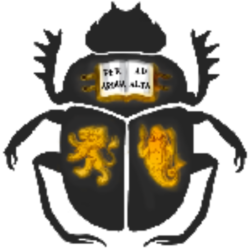On 30th April 2014 the facsimile tomb of Tutankhamun was opened in Luxor, situated just behind Carter’s House on the West Bank. The event was attended by a couple of hundred people (on estimate) including a number of inspectors and ambassadors. I was lucky enough to attend as a member of the ARCE team. The event included several short speeches about expectations for the tomb and how, not only will it help in the preservation of KV62 by diverting the tourists away from the original to the copy, but will also go some way to bring tourists to Luxor.
—–
After these speeches the tomb was opened and everyone flocked to be the first inside. There was a combination of diplomats, journalists, Egyptologists, archaeologists, students and ex-pats. The general feeling seemed to be upbeat and positive. The reconstruction of the tomb itself cannot be faulted, and the decoration in the burial chamber is almost unidentifiable from the real thing.
—–
The highlight of the exhibition, for me anyway, was the annexe which had been reconstructed and opened up. In this room there was a reconstruction of the wall decoration that was destroyed in order for Carter to enter the burial chamber. The original section of wall is now missing and this has been reconstructed using Burton’s black and white photographs and the colour pigments from the rest of the decoration. It was wonderful to see this. A spokesperson from Factum Arte, the company responsible for the reproduction, hoped it may help to locate the original. However, the only downside was, as it was possible to get closer to this than the decoration in the burial chamber it was obvious it was fibre glass and not painted plaster.
—–
I am torn about this reconstruction. As an Egyptologist I understand the need to close KV62 due to the damage being caused to the tomb decoration and this facsimile will enable people to still see what the tomb is like. However, although the reproduction is far superior, personally it felt no less ‘real’ than the reproduction of the tomb at Highclere Castle or at the Tutankhamun Exhibition in Dorchester.
I was a little surprised that the same movement restrictions are in place in the replica tomb of Tutankhamen as in the original, in the sense that the burial chamber is still off limits, meaning the scene to the left is still only visible if you hang over the barrier. To make it an improvement on the original and a draw for tourists, perhaps removing this barrier allowing people to enter the burial chamber to examine the artwork carefully would have been a better plan.
—–
I wholeheartedly feel that this replica is in the wrong place. It should be placed in Hurgada or Sharm el Sheikh allowing tourists to see the ‘tomb’ without the need to visit the Valley of the Kings. I am not sure I agree with the expectation that it will bring people to Luxor, especially at a time where original monuments are failing to draw the visitors. The tourist in me would not travel to Egypt to see a replica, no matter how accurate it is, and once I had arrived in Luxor I would visit the ancient tombs first in their original settings rather than a replica.
—–
Perhaps I will feel differently if Factum Arte complete their reproduction of the tomb of Sety I (KV17) as they plan to. This tomb has not been open for decades and is unlikely to be open again so it would be the only way to see it. Even then, would it be much different to looking at images in a book?
